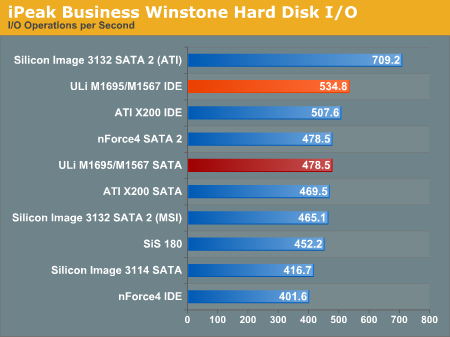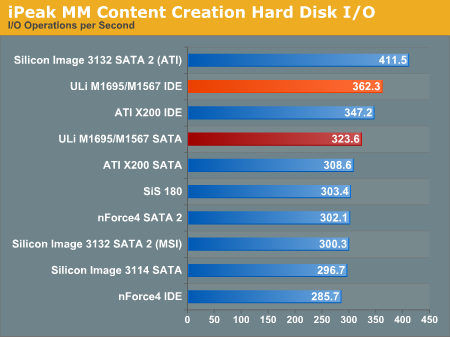ULi M1695 PCIe/AGP for Athlon 64 – Part 2 with SLI
by Wesley Fink on August 5, 2005 10:00 AM EST- Posted in
- Motherboards
Disk Controller Performance
With so many chipsets and brands of storage controllers on current Athlon 64 boards, we standardized on Anand’s storage benchmark, first described in Q2 2004 Desktop Hard Drive Comparison: WD Raptor vs the World, as a standard means of measuring disk controller performance. To refresh your memory, the iPeak test was designed to measure "pure" hard disk performance, and in this case, we kept the hard drive as consistent as possible while varying the hard drive controller. The idea is to measure the performance of a hard drive controller with a consistent hard drive. We played back Anand’s raw files that recorded I/O operations when running a real world benchmark - the entire Winstone 2004 suite. Intel's IPEAK utility was then used to play back the trace of all the IO operations that take place during a single run of Business Winstone 2004 and MCC Winstone 2004. To try to isolate performance difference to the controllers that we were testing, we used Seagate 7200.7 model SATA and IDE hard drives for all tests.iPeak gives a mean service time in milliseconds; in other words, the average time that each drive took to fulfill each IO operation. In order to make the data more understandable, we report the scores as an average number of IO operations per second so that higher scores translate into better performance. This number should not be used to report hard disk performance as it is just the number of IO operations completed in a second. However, the scores are useful for comparing “pure” performance of the storage controllers in this case.


In past benchmarking, IDE has provided the slowest IO performance in this roundup. However, ULi and ATI IDE break that trend, with IDE performance being the best that we have measured since we have been testing with iPeak.
There are no additional SATA/SATA2 controllers on the ULi M1695 Reference Board 2, but for IDE or SATA disk storage, the ULi M1567 delivers outstanding storage performance.










46 Comments
View All Comments
Wesley Fink - Saturday, August 6, 2005 - link
The 400 graph has been removed. After considering the questions here it is fair to say the ULi tests were not run under the same test conditions (due to no DDR Voltage controls and limited vCore adjustments) and should not be directly compared. The 242 remains since it was achieved with the same test conditions.Wesley Fink - Friday, August 5, 2005 - link
Yes, this is the only board using the FX57 in OC testing, but we will be testing with the FX57 in the future. Yes, that makes it an unfair comparison.It really was not possible to use our normal OC tests because the Reference board has no memory voltage adjustments at all. We stated this very clearly in the reviews. The option was to report very low results, or to make changes to the test to show how high the board could actually go in overclock (400 clock speed). We chose to show what the board could do on OC, but the results are not directly comparable to past results.
Lonyo - Friday, August 5, 2005 - link
OCZ BOOSTER FFS!!!!Aquila76 - Friday, August 5, 2005 - link
So if you want to run SLI, you have to use that riser card, right? How exactly does that fit in a standard ATX case? The cards are 90 degrees from their normal position. I understand that this is a good board if you're going to use older AGP cards and want an upgrade path; but I would think they could make it a lot cheaper if they left SLI capability off as it seems rather pointless in this format.kmmatney - Saturday, August 6, 2005 - link
I thought the same thing, but yes, its just a prrof of concept - the retail board makers will implement it without the need for a riser card.MarkB - Friday, August 5, 2005 - link
I think it's more of a proof of concept for showing off the chipset's capabilities, instead of making a whole new reference board to house the 2 x8 pci-e slots.I doubt any retail board would use the riser approach.
Sunbird - Friday, August 5, 2005 - link
Here is South Africa the ASRock 939A8X-m based in this ULi chipset has arrived at our local reseller last week.Its a mATX board and has SATA raid and all the other usual stuff. Near the bottom price range of the local market (aka cheap).
grug2k - Friday, August 5, 2005 - link
The AsRock 939AX-M is NOT a ULi M1695 board. It's an old AGP-only board based on the ULi M1689 chipset.lsman - Friday, August 5, 2005 - link
Computex2005 show also has Jetway A695DAG, Chaintech S1695-2WT - Friday, August 5, 2005 - link
This board should be on the short list (hehe, so short there is only one name on it) of boards for the DIY builder looking to keep their current AGP card and move to PCI Express down the road. There are a lot of users that fit that description so this board makes sense in every way. The only downside will be whether the boards are actually produced by some quality vendors who are not stuck on the Nvidia bandwagon.My S754 setup is adequate for any game that I play, so I should be able to make another year on it. After that, S939 and a 3800+ x2 makes more sense, but after buying that, I won't have the $ left to splurge on a mid-high end PCI Express video card. My 6800 cost $295 when I bought it, so moving that to the S939 setup makes financial sense.